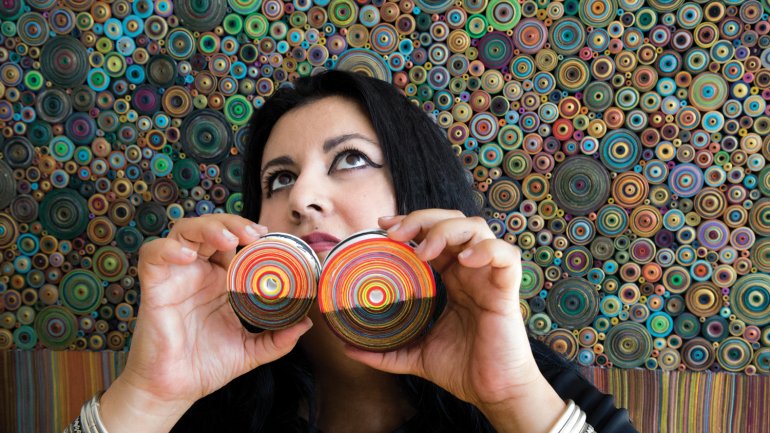Bibliophile
Bibliophile
The cost of an MFA degree has spurred jokes about starving artists and ramen noodles, but it’s often a reason art students scrimp on materials. In her early years at Pratt Institute, Hadieh Shafie says she “would paint on anything” – discarded wood paneling, scrap metal, leather – to save money. One day at an art supply store, she came across a stack of wrinkled Italian Fabriano paper that was headed for the trash. Intrigued by the odd creases, she got some ink and started fooling around. That’s when she realized that, instead of trying to paint on the paper, perhaps she could make art out of the paper itself.
“That’s when my whole love and passion for paper started,” Shafie says. “I never looked back.”
Shafie graduated from Pratt in 1999, but it would take another 10 years for her to become a self-sufficient, full-time artist and perfect her process for making mixedmedia works.
In 2015, the Iranian-born Shafie celebrated her first solo New York show – and if that weren’t enough of a marker of success, consider this: The once-starving student has hired an intern. And she needs the help, given the legwork it takes to collect her materials and the intensive handwork required to make each piece.
“The work has many different layers and processes that come together,” Shafie says. Although she simultaneously prepares materials for multiple works, it can take months to complete a composition, even after nearly a decade of becoming more efficient. The basis for most of her pieces has been scroll-like rolls of paper that she refers to as ketabs, the Farsi word for “book.”
“I’m fascinated by books – and reinterpreting what a book can be,” Shafie says. Most of her works feature text, but the lettering lies beneath layers of paint and paper. (Hidden Words is the title of a 2014 catalogue of her work published by Leila Heller Gallery.) Shafie’s multi-step process borrows from quilling, but also incorporates elements of calligraphy and color-field painting.
“Her works really defy categorization, and that is part of what is so attractive about them,” says Lauren Pollock, director of Leila Heller Gallery. “Every time I visit her in her studio, she is pushing the boundaries further. Her work is incredibly labor- and time-intensive, and that really appeals to people.”
Shafie begins the labor in her Brooklyn studio, making a drawing of the Farsi word eshgh, which can be translated as “love” or “passion”; then she has the drawing printed onto paper, which is cut into 1-by-11-inch strips. Next she paints the edges of the strips, carefully choosing the palette, mindful that her end goal is to create an optical illusion, suggesting many colors, though she uses only a handful of hues on the edges. Layering white strips of paper next to red and orange ones will create the illusion of peach, for example.
“The work is about color, on the surface,” Shafie says. “The work might only have five colors in it, but your eye starts mixing.”
When the paint is dry, she draws or writes “eshgh” on each strip of paper (which, corresponding to the ketab concept, she calls a “page”). Once she has a stockpile, she begins rolling the pages into a ketab. She chooses a knitting needle from the jars of dozens she stores in her studio, carefully wrapping the strips around the needle and strategically adding new pages for size and color. Most ketabs end up being 3 to 5 inches in diameter; they resemble rainbow hockey pucks.
The finished rolls are then arranged in a custom-made gessoed frame. Arranging them is a bit like playing Tetris, but once she’s satisfied with the final composition – usually a circle or rectangle – she slathers the back of each ketab with bookbinding glue and waits for the finished tome to dry.
“To really see a work, I have to make it,” she says. Though she does color studies and sample ketabs, she doesn’t create an advance sketch, as she used to for paintings. Skipping the drawing stage is a big change for a woman who grew up carrying around a sketchbook like it was her fifth appendage. Shafie was 5 when she asked her father to buy her a sketchbook, and she insisted it be one “for adults.”
“It was probably the first time I ever touched paper, and I was really excited about that paper,” she recalls. “Drawing and making art were really important to me.”
Shafie’s family immigrated to the United States when she was 13. Her father had been an engineer but ended up opening a framing shop in the Washington, DC, suburbs. “That worked out well for me,” she jokes.
At 47, she finds herself draw-ing more and more on her Persian heritage, and has been featured in exhibitions and articles focused on art from the Middle Eastern diaspora. She’s preparing for a show in Dubai, has exhibited in Abu Dhabi, and was shortlisted in 2011 for a contemporary Islamic art prize awarded by London’s Victoria and Albert Museum.
The label “Islamic art” has become something of a buzzy misnomer, however, and that troubles her a bit. Islam is a religion,” she says, “but my work is not religious.”
Instead, she looks to her culture for iconography. Secular Persian poetry inspires Shafie, not the Koran. And as she traces Farsi words each day, she continues to find deep meaning in making her own hand-rolled scrolls.
Rebecca J. Ritzel is a freelance journalist in Alexandria, Virginia.

